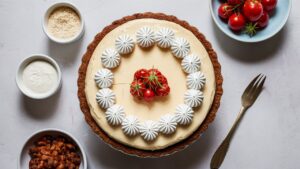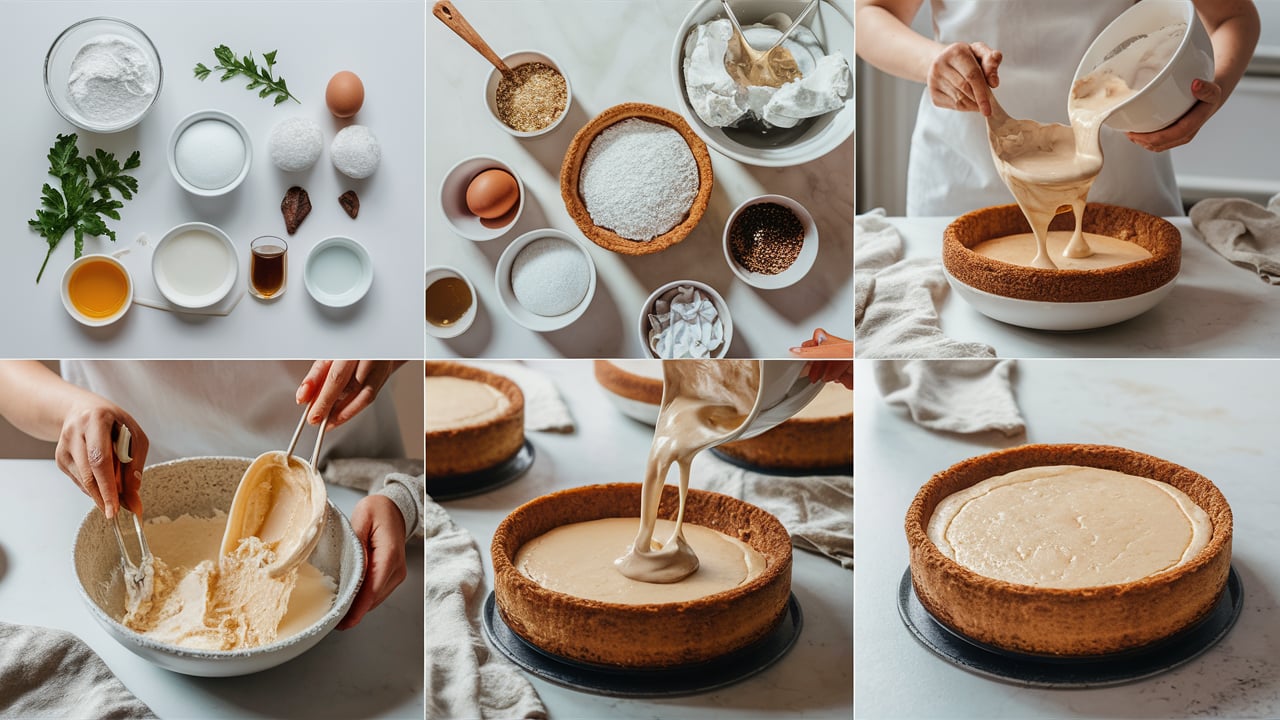Philadelphia cheesecake is a beloved dessert, famous for its rich and creamy texture. Whether you’re new to baking or an experienced cook, learning how to make a Philadelphia cheesecake at home can be incredibly rewarding. In this guide, we’ll walk you through every step, from selecting the best ingredients to mastering the baking technique. By the end, you’ll be able to create a cheesecake that rivals any bakery.
Part 1: Introduction to Philadelphia Cheesecake
What is Philadelphia Cheesecake?
Philadelphia cheesecake, named after the famous Philadelphia cream cheese, is a classic American dessert known for its smooth and luxurious texture. While many cheesecakes can be dense, the Philadelphia style strikes a perfect balance between richness and creaminess, making it a favorite among cheesecake lovers. The main difference between this and other cheesecakes, such as New York-style cheesecake, lies in its simplicity and the use of Philadelphia cream cheese as the base ingredient. Learn more about the difference between New York and Philadelphia cheesecake to understand these variations better.
Why Choose Philadelphia Cream Cheese?
The Philadelphia brand has become synonymous with quality cream cheese. Using full-fat Philadelphia cream cheese ensures that your cheesecake will have that unmistakable rich flavor and smooth texture. Many bakers prefer it for its consistent results and ability to blend seamlessly with other ingredients. For more tips on perfecting your cheesecake, check out the secret to the best cheesecake.

Part 2: Essential Ingredients for Philadelphia Cheesecake
Creating the perfect Philadelphia cheesecake starts with choosing the right ingredients. Here’s a breakdown of what you’ll need:
- Cream Cheese: Full-fat Philadelphia cream cheese is essential for that signature creamy texture. Make sure to let it soften to room temperature before mixing to avoid lumps.
- Crust Options: The traditional graham cracker crust is made from graham crackers, melted butter, and sugar. However, you can also try alternative crusts like digestive biscuits, Oreos, or gluten-free options. To prevent a soggy crust, pre-bake it for about 10 minutes before adding the filling.
- Sweeteners: Granulated sugar is the standard sweetener, but brown sugar or even natural sweeteners like honey can add unique flavors.
- Eggs: Eggs are crucial for binding the cheesecake and providing structure. Using room-temperature eggs helps ensure smooth blending and prevents overmixing, which can lead to cracks.
- Flavorings: Vanilla extract is the classic choice, but you can add lemon zest, almond extract, or even a touch of coconut extract for a twist on the traditional flavor.
Part 3: Tools You Need to Make the Perfect Cheesecake
Making a Philadelphia cheesecake requires a few essential tools:
- Springform Pan: This pan is essential for easy removal of your cheesecake without damaging its structure. Learn more about using a springform pan effectively.
- Mixer: Whether you use a stand mixer or a hand mixer, ensuring your cream cheese is perfectly smooth is key to avoiding lumps in your cheesecake.
- Measuring Tools: Precise measurements are vital for a perfect cheesecake. Invest in a good set of measuring cups and spoons.
- Spatula and Mixing Bowls: A spatula for scraping the sides of your bowl and mixing bowls of various sizes will help you prepare your ingredients.
- Water Bath Setup: A water bath (bain-marie) helps prevent cracks in your cheesecake by providing gentle, even heat during baking.
Part 4: Step-by-Step Guide to Making Philadelphia Cheesecake
Now that you have your ingredients and tools ready, let’s walk through the process of creating your cheesecake.
Step 1: Preparing the Crust
- Crush the Graham Crackers: Place graham crackers in a food processor and pulse until fine crumbs form. Alternatively, you can use a rolling pin and a sealed plastic bag.
- Mix with Butter and Sugar: Combine crushed graham crackers with melted butter and sugar until the mixture resembles wet sand.
- Press into the Pan: Press the mixture firmly into the bottom of a springform pan, ensuring an even layer.
- Pre-Bake the Crust: Bake at 350°F (175°C) for 10 minutes to set the crust, then let it cool while you prepare the filling.
Step 2: Making the Cheesecake Filling
- Beat the Cream Cheese: In a large mixing bowl, beat softened Philadelphia cream cheese until smooth and creamy. Use a hand mixer or stand mixer on medium speed.
- Add Sugar and Flavoring: Gradually add sugar and vanilla extract, continuing to beat until fully incorporated.
- Add Eggs One at a Time: Add eggs one at a time, beating on low speed until just combined after each addition. Avoid overmixing.
- Pour Over the Crust: Once the filling is smooth, pour it over the cooled crust in the springform pan.
Step 3: Baking the Cheesecake
- Bake in a Water Bath: To prevent cracks and ensure even baking, place the cheesecake in a water bath. Wrap the bottom of your springform pan in aluminum foil and place it in a larger roasting dish. Pour hot water into the roasting dish until it reaches halfway up the sides of the pan.
- Bake at 325°F (160°C): Bake for 55-70 minutes, or until the center is almost set but still slightly jiggly.
- Cool Gradually: Turn off the oven and let the cheesecake sit with the door slightly open for one hour. Gradual cooling helps prevent cracks.
- Chill: Allow the cheesecake to cool to room temperature before refrigerating for at least 4 hours or overnight.

Part 5: Cheesecake Variations and Toppings
One of the best things about cheesecake is its versatility. Here are some ways to adapt this recipe:
- Fruit Toppings: Add fresh berries, sliced peaches, or a berry compote to your cheesecake for a refreshing contrast to the rich filling.
- Chocolate Cheesecake: Add melted chocolate to the batter or swirl chocolate into the mix before baking for a decadent twist. For a fun variation, explore the Snickers cheesecake recipe.
- Nut and Spice Variations: Incorporate spices like cinnamon or nutmeg into the crust, and top the cheesecake with toasted nuts like pecans or almonds for extra flavor and texture.
- Savory Cheesecake: Explore savory versions by incorporating ingredients like goat cheese, smoked salmon, or sun-dried tomatoes.
Part 6: Cheesecake Pairings
Pairing your cheesecake with the right drink or side can elevate the entire dessert experience:
- Wine Pairings: A buttery Chardonnay with notes of vanilla complements the creamy texture of the cheesecake. Alternatively, Champagne cuts through the richness of the cheesecake, making it feel lighter on the palate. Check out these wine pairings with cheesecake for more ideas.
- Coffee Pairings: A strong espresso provides a nice contrast to the richness of cheesecake, while flavored coffees like hazelnut or vanilla enhance the cheesecake’s flavor.
- Side Pairings: Fresh fruit salad balances the richness of the cheesecake with its acidity and sweetness. A dollop of whipped cream can make each bite even more indulgent.
Part 7: Common Cheesecake Mistakes and How to Avoid Them
Cheesecake can be tricky to master, but here are some common mistakes and how to avoid them:
- Cracked Cheesecake: This often happens due to overmixing, overbaking, or not using a water bath. Mix ingredients just until combined and always use a water bath to maintain consistent baking temperature.
- Soggy Crust: Prevent a soggy crust by pre-baking it and ensuring your springform pan is tightly wrapped in foil before placing it in the water bath.
- Lumpy Batter: Ensure that your cream cheese is softened to room temperature before mixing, and beat it until smooth before adding other ingredients.
Part 8: Storage and Leftovers
Cheesecake is best served chilled, but proper storage is key to maintaining its freshness:
- Storing in the Refrigerator: Cheesecake can be stored in the fridge for up to 5 days. Be sure to cover it with plastic wrap or place it in an airtight container to prevent it from absorbing other flavors.
- Freezing Cheesecake: For longer storage, freeze your cheesecake. Wrap it tightly in plastic wrap and aluminum foil. It can be frozen for up to 3 months. Thaw in the refrigerator overnight before serving.
- Reheating Cheesecake: If you prefer your cheesecake warm, heat individual slices in the microwave for 10-15 seconds. Be careful not to overheat, as this can cause the cheesecake to lose its creamy texture.
Part 9: Cultural Significance of Cheesecake
Cheesecake has a rich history, dating back to ancient Greece. Today, it is enjoyed worldwide, with each culture adding its twist to the classic dessert:
- New York Style Cheesecake: Known for its extra creamy and dense texture, New York cheesecake uses more cream cheese and egg yolks, resulting in a richer flavor.
- Italian Cheesecake: Also known as “Torta di Ricotta,” Italian cheesecake uses ricotta cheese instead of cream cheese for a lighter, fluffier texture.
- Japanese Cheesecake: A lighter, fluffier version of the dessert, Japanese cheesecake is made by folding whipped egg whites into the batter, resulting in a light and airy texture that melts in your mouth.

Part 10: FAQs
- How Can I Prevent My Cheesecake from Cracking?
- Prevent cracks by using a water bath, avoiding overmixing, and cooling the cheesecake slowly. For more details, see our tips on using a springform pan.
- Can I Make a No-Bake Version of Philadelphia Cheesecake?
- Yes! A no-bake cheesecake is a great alternative if you’re short on time. Simply mix softened cream cheese with whipped cream, sugar, and your choice of flavorings, then pour into a pre-made crust and chill for at least 4 hours.
- How Do I Know When My Cheesecake Is Done?
- Cheesecake is done when the edges are set, but the center is still slightly jiggly. The top should have a light golden color. Avoid overbaking, as this can lead to a dry cheesecake.
- What Toppings Go Best with Philadelphia Cheesecake?
- Philadelphia cheesecake pairs well with a variety of toppings, from fresh fruit and berry compotes to chocolate ganache or caramel sauce. You can also add crushed nuts or cookie crumbs for extra texture.
- How Can I Make My Cheesecake Healthier?
- To make a healthier cheesecake, consider using low-fat cream cheese or Greek yogurt. You can also reduce the sugar by using natural sweeteners like honey or stevia. For a lower-carb option, try a nut-based crust instead of a traditional graham cracker crust.
Conclusion
Making a Philadelphia cheesecake from scratch is a satisfying experience that allows you to create a delicious, creamy dessert that will impress your friends and family. By following this detailed guide, you’ll master the art of cheesecake-making and enjoy a treat that’s perfect for any occasion. With practice and patience, you’ll be well on your way to creating a cheesecake that’s both delicious and unforgettable.

